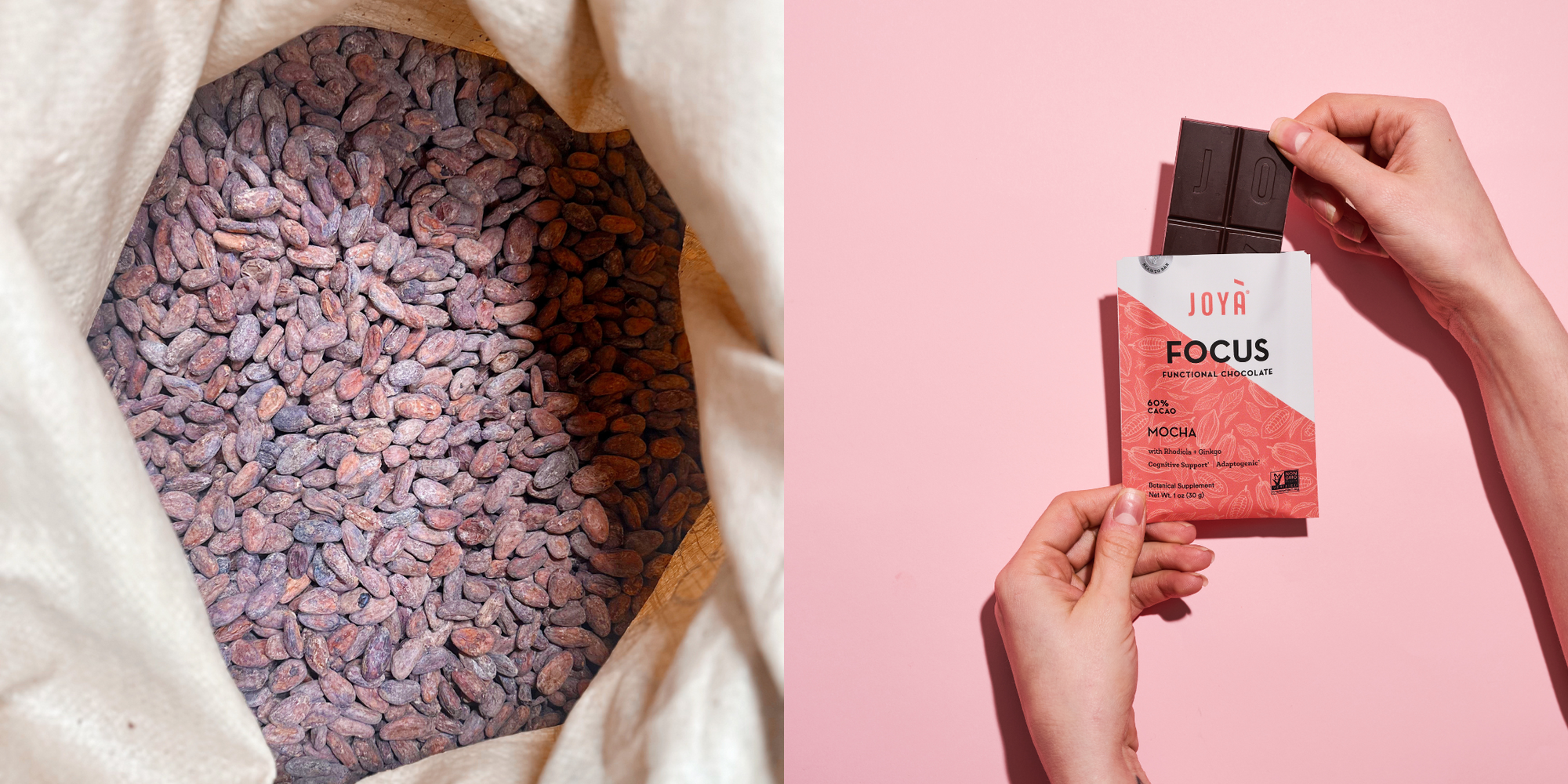What is Bean to Bar Chocolate?

You might have heard the term “bean to bar” associated with artisanal chocolate and assumed it has something to do with quality. If so, you’re right! But if you’re not sure exactly what this term means, you’ve come to the right place.
Chocolate starts with a fruit
Wait.. what? My favorite indulgent treat is a fruit? That's right! Chocolate is made from cacao beans, which are the seeds of the football-shaped fruit from the Theobroma cacao tree.
"Bean to bar" refers to the process of making chocolate starting from the cacao bean, all the way through to the finished bar, typically in relatively small batches.
Now you might be wondering, “doesn’t all chocolate start from cacao beans?” And you’d be right. So let’s take a step back for some context.
There are three main categories of producers of chocolate products:
1. Large scale chocolate manufacturers
Think of the large, global names in chocolate (e.g. Cadbury, Hershey, Callebaut, Nestle). These manufacturers produce chocolate from cacao bought in bulk, often from multiple origins (aka growing locations) mixed together, and with little transparency when it comes to growing practices, such as growers that work under less favorable conditions or that are paid less than fair wages.
This cacao sourced in mass is also often more standard when it comes to taste and aroma, and the finished chocolate product often contains added flavors, fillers and lots of sugar.
2. Chocolatiers
These manufacturers create chocolate confections such as truffles and chocolate candies, rather than actual chocolate. They use already made chocolate, which they source from the large scale manufacturers discussed above and then melt to create their confections.
3. Bean to bar chocolate makers
These chocolate makers are small batch producers who purchase cacao beans in small lots, and perform every step of the chocolate making process themselves – from cleaning the beans, all the way to the final step of unmolding and packaging.
Craft producers coined the term “bean to bar” to describe the chocolate making process from cacao bean to chocolate bar – a shorthand for the multi-step process of small-batch chocolate making.
Bean to bar chocolate is most often associated with ethically, fairly or directly traded cacao, with a focus on transparency in both sourcing and manufacturing, as well as on complex flavors and aromas. Each type of chocolate bar is also typically made from cacao from a single origin.
Keep reading as we dive into the entire bean to bar process below, step by step.

Why is bean to bar chocolate so expensive?
The short answer: scale and quality.
Your typical grocery store chocolate, even from more premium positioned brands, is made by those large scale chocolate manufacturers. That means:
Scale
Mass produced chocolate is made in very large, very efficient machines pumping out massive volumes of chocolate at a time. Packaging and ingredients are also purchased more cheaply at scale.
On the other hand, bean to bar chocolate makers produce in small batches and have far more overhead costs and supply costs.
Cacao cost
Large scale manufacturers purchase bulk cacao at much lower prices than a bean to bar chocolate maker purchasing small lots of high quality cacao.
The complete process, from bean to bar
We already alluded to the bean to bar chocolate making process being long, but if you haven’t seen it, get comfy as you might get tired just reading it!
Here’s how JOYÀ’s bean to bar Functional Chocolate is made, starting on the farm:
STEP #1: FERMENTATION
The cacao fruit is filled with a few dozen seeds coated with a white, sweet pulp. The pulp-coated seeds are fermented for several days, a process that develops aromas and flavors.
STEP #2: DRYING
After fermentation, the beans are dried to reduce their moisture content and prevent them from molding. Once dried, they’re packed into big burlap sacks and shipped out to customers…. Like JOYÀ!
STEP #3: FORMULATION
Before we start making chocolate, we work on our recipe, which is more complex than for non-functional chocolate.
Not only do we need to determine the cacao percentage and desired tasting notes, sweetness and mouthfeel – we also need to consider the product’s intended health benefits, the dosage and compatibility of the ingredients that will deliver those benefits, and how those ingredients will “play” with the cacao to create unique tasting notes.
Prior to production, our ingredients are also 3rd party lab tested to ensure safety and quality.

STEP #4: SORTING + ROASTING
In the first step of production, the beans are separated from debris that made its way into the sacks, such as stones, leaves and twigs.
The beans are then roasted, creating deeper flavors, further reducing moisture, killing any bacteria, and loosening the beans’ outer shell, or husk.
STEP #5: WINNOWING
After roasting, the beans are cracked and winnowed, a process that separates the inner bean from the shell, and then cracks the bean into small nibs.
(These are the cacao nibs that you might buy at the grocery store to sprinkle on your oatmeal and smoothie bowls!)

STEP #6: GRINDING + CONCHING
The nibs are then ground into a very thin and smooth paste, reducing particle size low enough so that our tongue won’t detect any grittiness when we enjoy the final bar.
Any other ingredients (cacao butter, coconut sugar, herbal extracts) are then added and blended into this liquid paste, and finally, during “conching”, heat and airflow evaporate volatile oils and further develop texture and reduce moisture.
STEP #7: TEMPERING + COOLING
If you’re ever tried melting chocolate to pour over snack bars or make homemade chocolate bark, you probably noticed that once hardened, the chocolate doesn’t have that same sheen as store-bought chocolate.
Tempering is a process that involves heating, cooling and reheating that stabilizes the chocolate’s fat molecules, and results in that satiny sheen and snap you hear when you break a chocolate bar. Once the liquid chocolate is “in temper”, it’s poured into molds and cooled into bars.

STEP #8: DE-MOLDING, PACKAGING + LAB TESTING
Once cooled, the bars are removed from their mold, slid into pouches and sealed.
But there’s one more step before we can ship them out: we need to ensure that the final product is pure and safe to consume, so we send production samples off to a 3rd party lab to test for heavy metals, microbes and other toxins.
As soon as we get the all-clear from the lab, the bars are ready to enjoy!
Shop JOYÀ bean to bar Functional Chocolate

